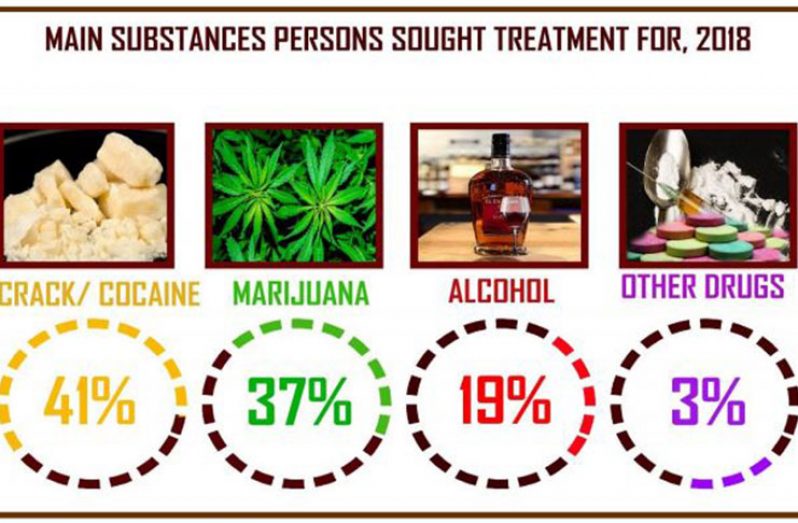– NANA report
SOME 106 persons sought treatment for problematic drug use disorders in 2018 at the Phoenix Recovery Project and the Salvation Army Men’s Social Centre, the National Anti-Narcotics Agency (NANA) has reported.
The agency in its Guyana Drug Information Network (GUYDIN) Report 2019, said data for 2018 indicates that the most abused licit drug is alcohol while the most abused illicit drugs are crack, cocaine and marijuana.
Of the overall total, 44 persons were admitted for cocaine use and its derivatives (41 per cent), 39 for marijuana abuse (37 per cent), 20 for the problematic use of alcohol (19 per cent) and two per cent for tobacco and one person who indicated cross addiction but did not specify a substance.
Last year, 99 males and seven females were enrolled into a treatment facility.
Given that the Phoenix Recovery Project is the only treatment that provides services to females with a 10-bed capacity, females are in the minority of persons that have been receiving treatment for problematic drug use disorders.
However, looking at the number of females who access the facility annually, there is a clear indication that there is a demand for treatment services for women.
Looking at the characteristics of persons who sought treatment in 2018, it was observed that these persons were between the ages of 17-65 years old with a heavy concentration between the ages of 20-49 years old.
Further analysis indicated that most persons (37) were between the ages of 11-15 years old when they first began using drugs and alcohol.
Of those in treatment, nine persons (eight per cent) had completed their tertiary studies, while 38 persons (36 per cent) completed their secondary education. The remainder had some secondary education or lower.
An assessment of the employment status of persons in treatment revealed that 59 persons were classified as working/self-employed while 24 were unemployed (23 per cent).
Four persons indicated that they were working and studying.
In assessing the source of referral to treatment, it was revealed that the 84 persons (79 per cent) were encouraged to seek treatment for their problematic substance use by their family and friends, while 13 persons (12 per cent) voluntarily enrolled themselves into a treatment programme.
REFERRAL
Moreover, three persons (three per cent) were referred by a healthcare provider and two were referred through the justice system.
One person in treatment was encouraged to seek treatment through the school system. The report noted that understanding a person’s motivation to enter treatment or their support system is essential in developing that person’s treatment regime and for preparing them for reintegration into society.
In assessing the drug using patterns of persons in treatment for the period, the statistics highlighted that 25 per cent of the problematic substance users were misusing a single drug compared to 75 per cent of those who were misusing multiple drugs.
Further analysis indicated that 52 persons enrolled into the treatment programme for 2018 were previously enrolled into another treatment programme with only 24 of those persons completing the programme.
Persons were also asked about their mental health history at which it was revealed that 36 persons were diagnosed with a psychiatric disorder.
Additionally, the report noted that persons were screened for any contagious diseases and it was revealed that of the 106 persons in treatment for the period, 66 were tested for a contagious disease.
Out of these 66 persons, eight tested positive for one of the following: HIV and other STDs, Hepatitis B and C, and Tuberculosis (TB) of which only two persons are receiving treatment for TB.
The high percentage of those individuals who use multiple substances and had a co-occurring psychiatric disorder makes it difficult to administer effective treatment to properly meet their needs and may lead to persons either not completing the treatment programme or being at risk of a relapse.
During the reporting period, the level of interaction between persons in treatment and the criminal justice system was also assessed.
It was revealed that of the 106 persons in treatment, 56 (53 per cent) were arrested at least once in their lifetime. Of these 56 persons, 34 persons were arrested within the last year and 10 of those persons were arrested two or more times during that period.




.png)









